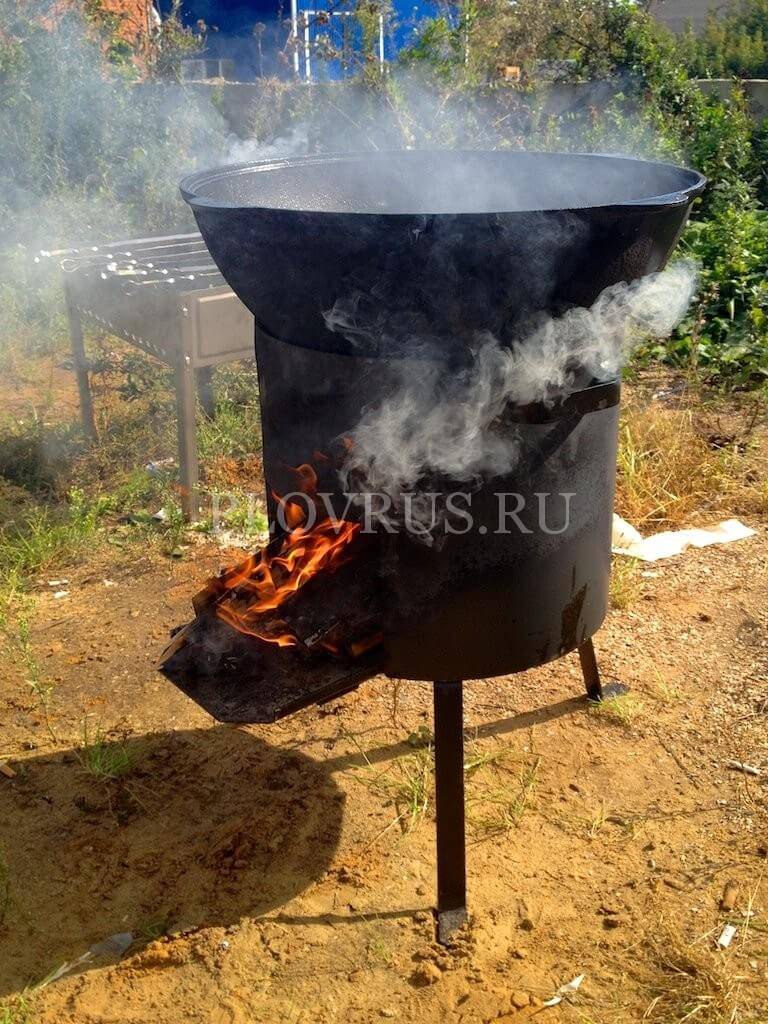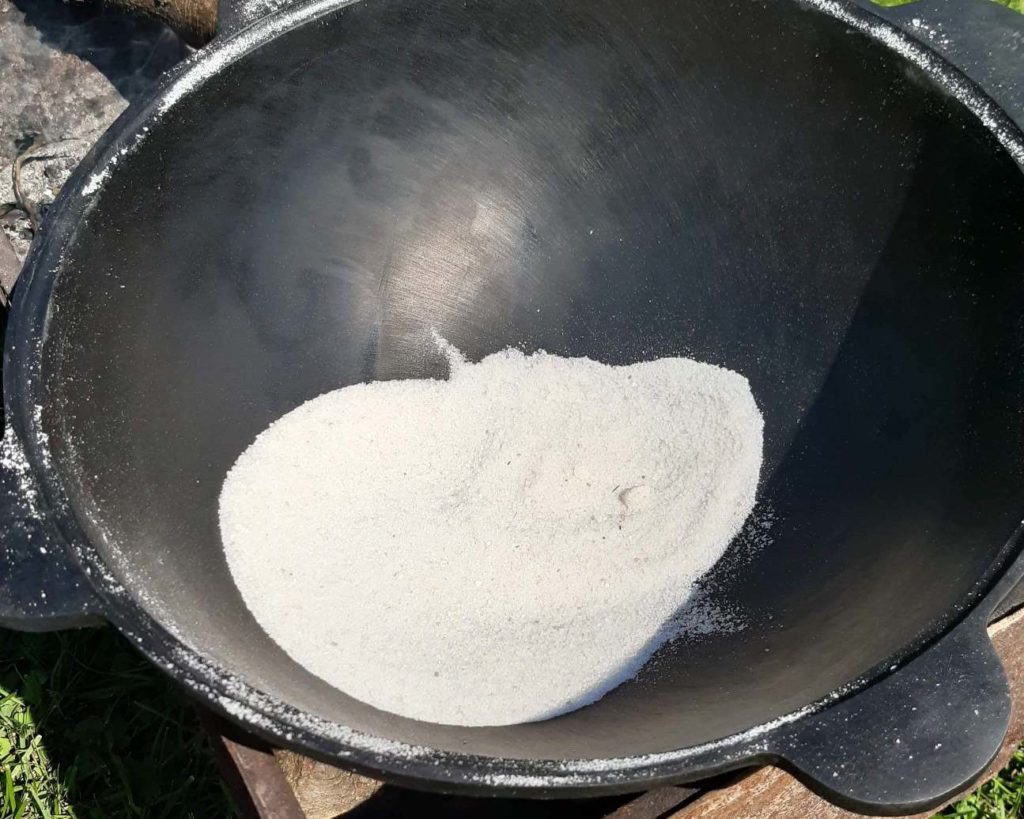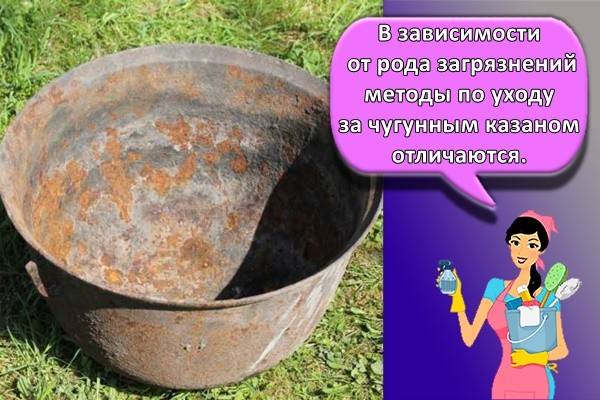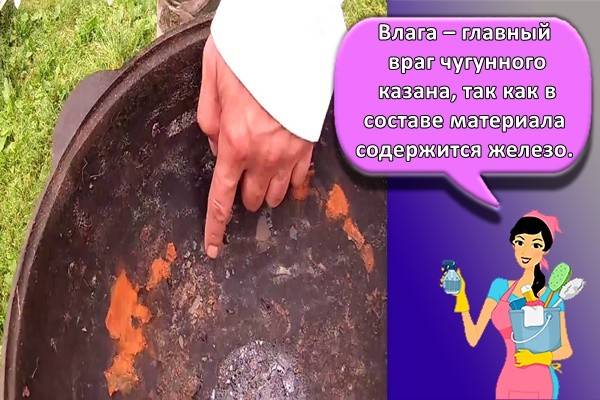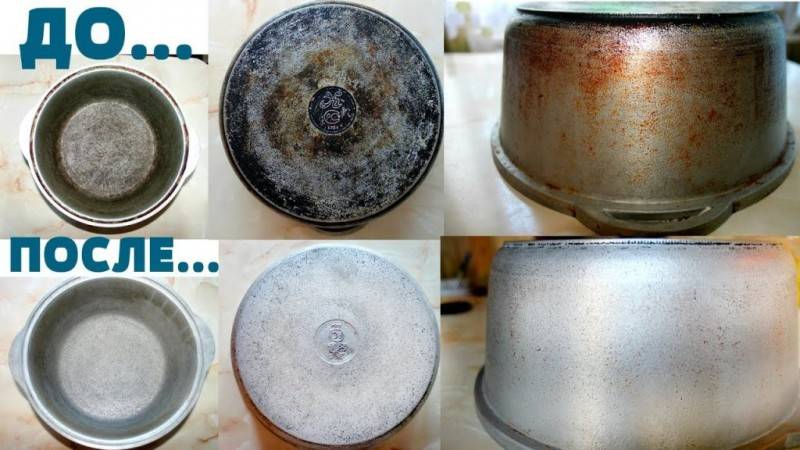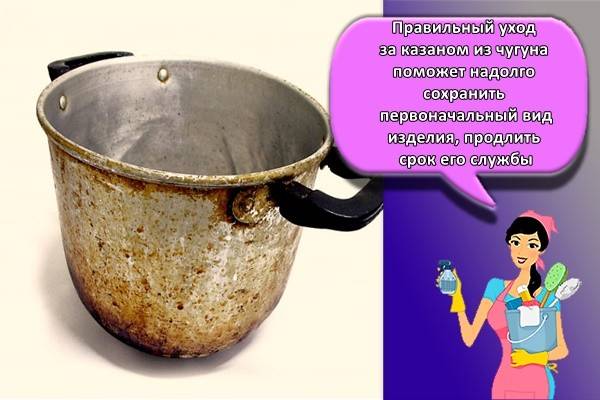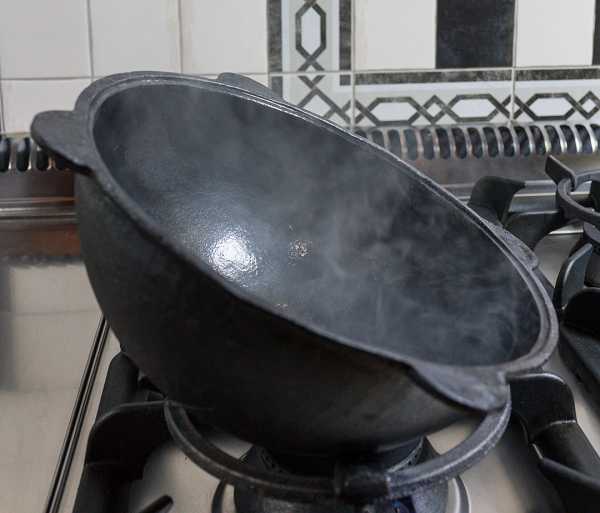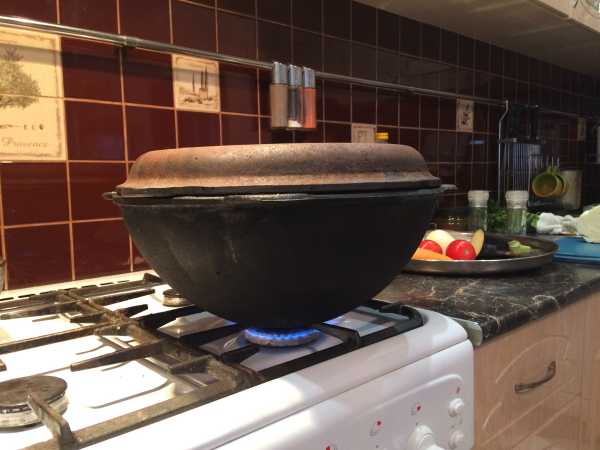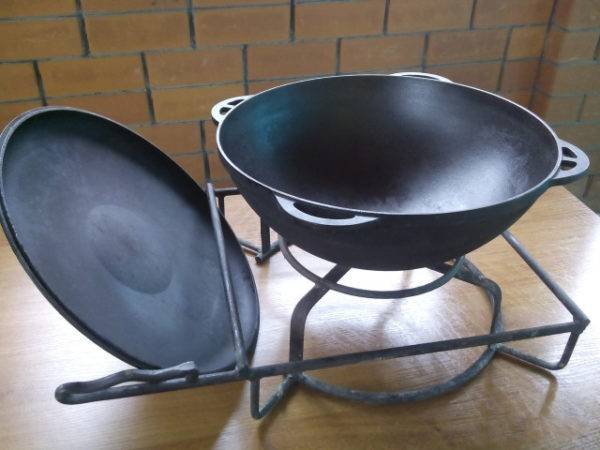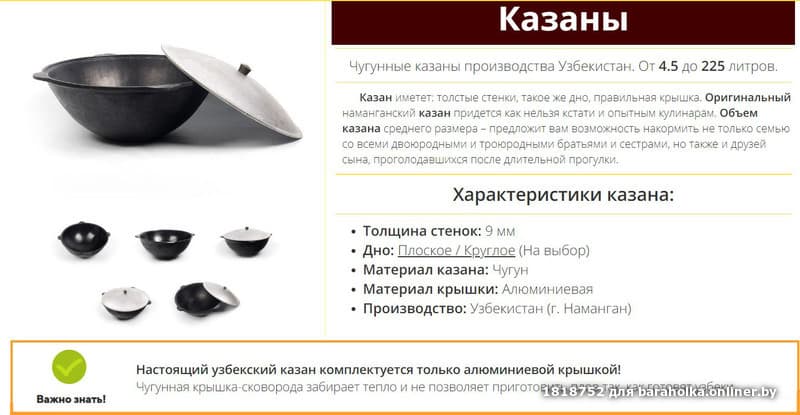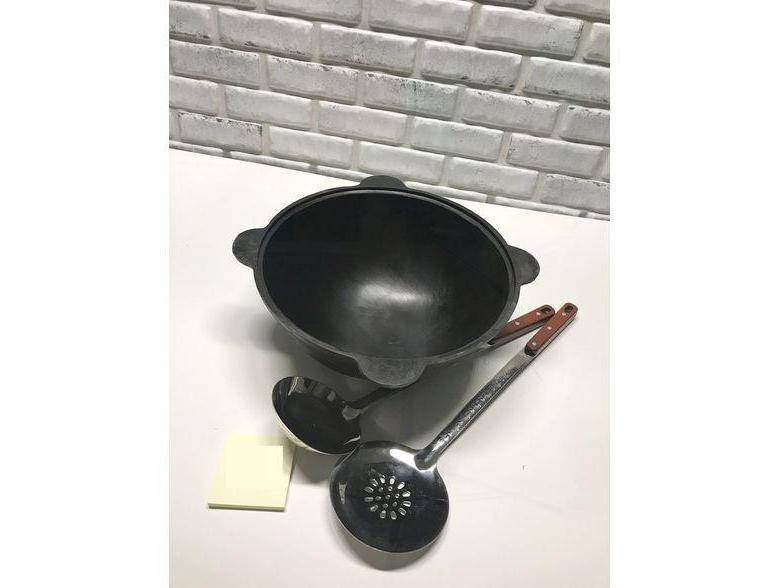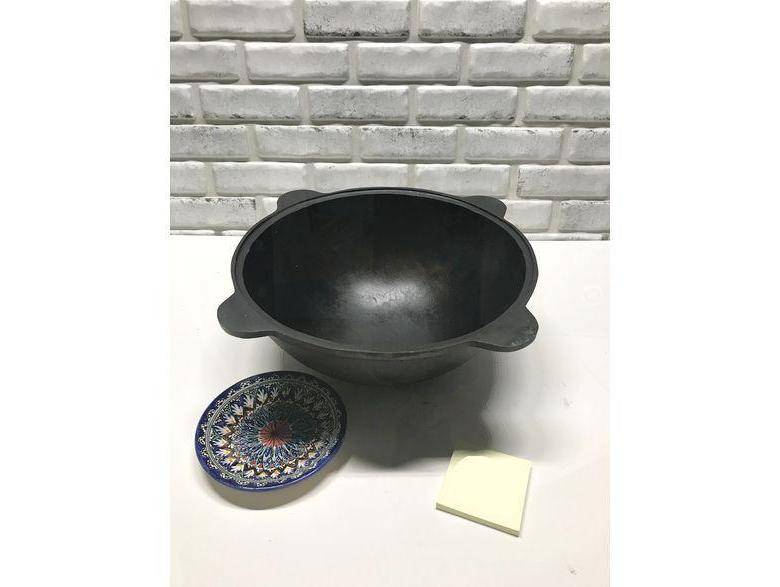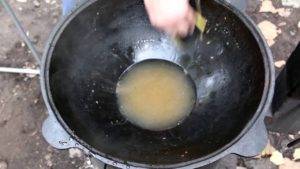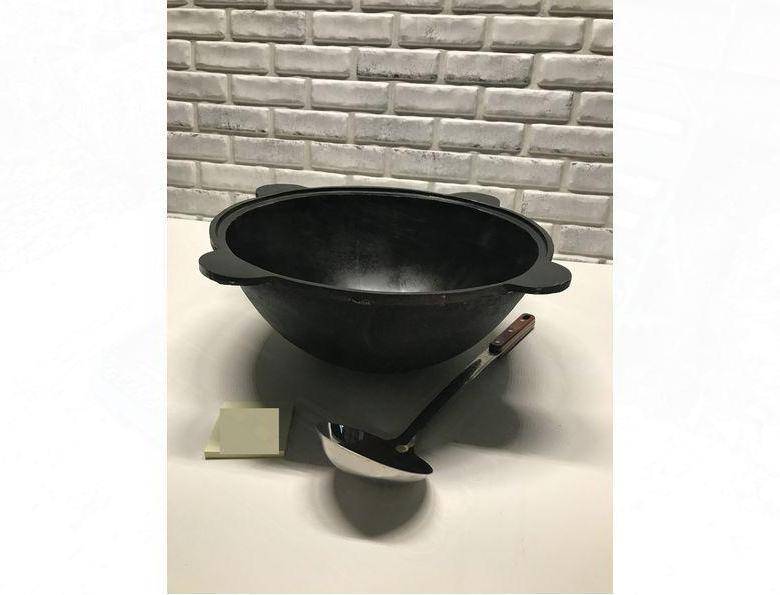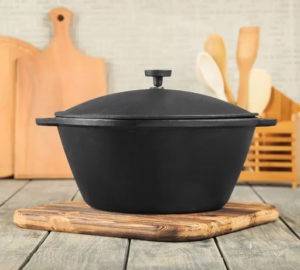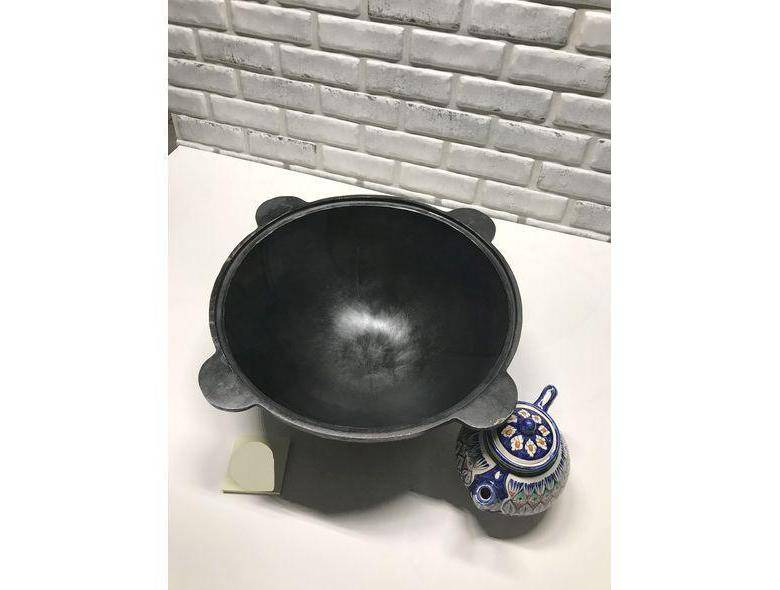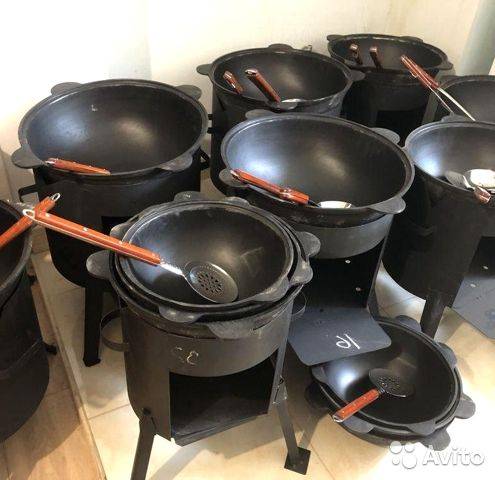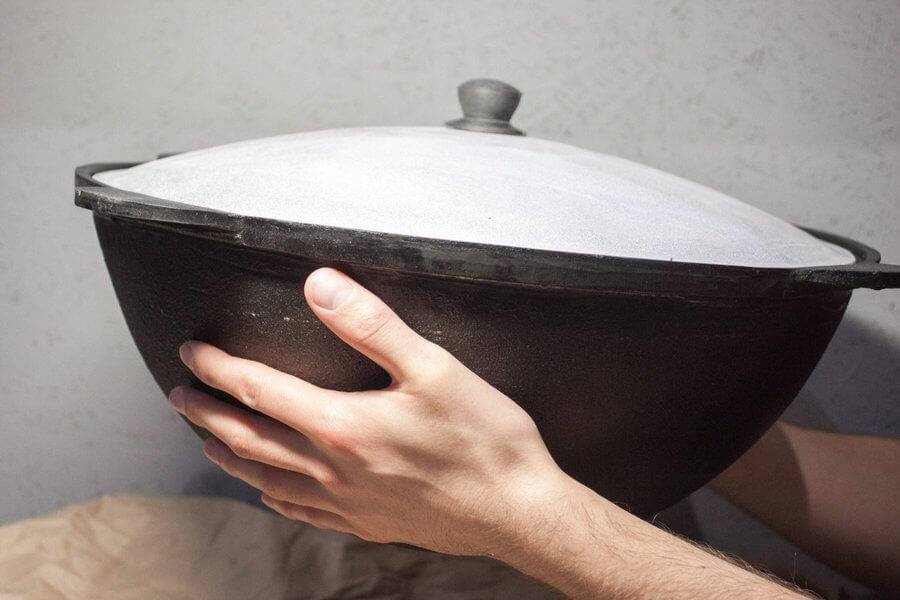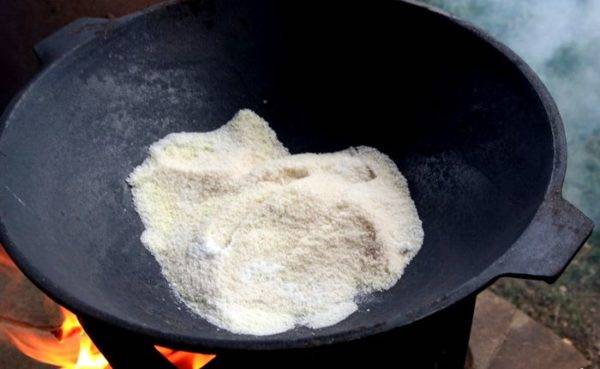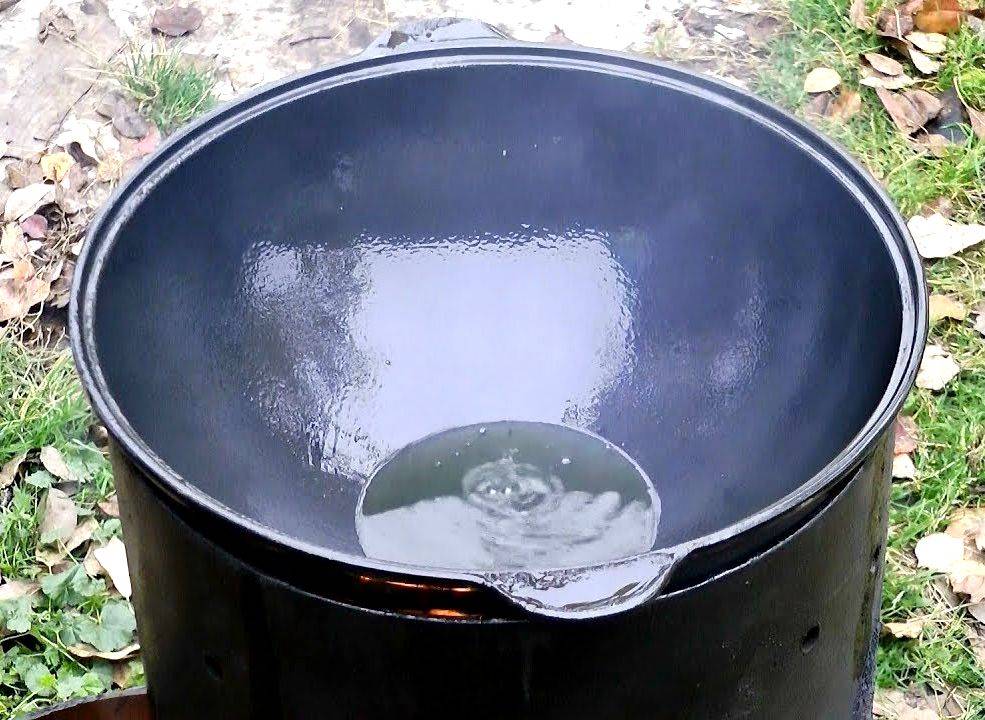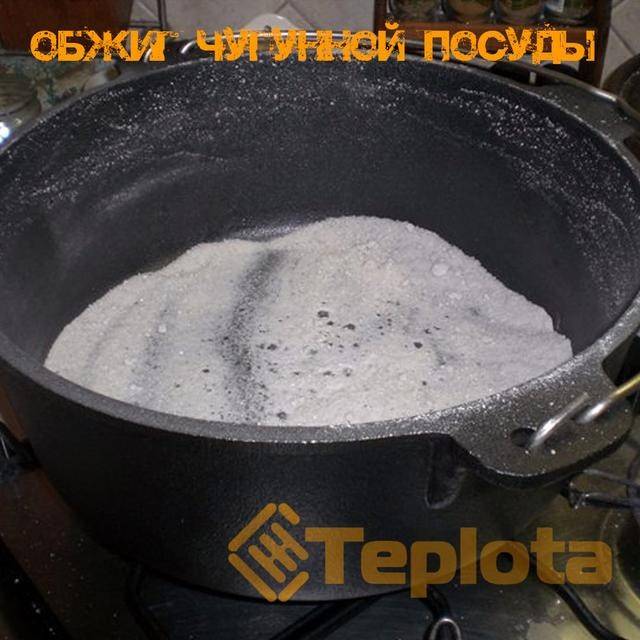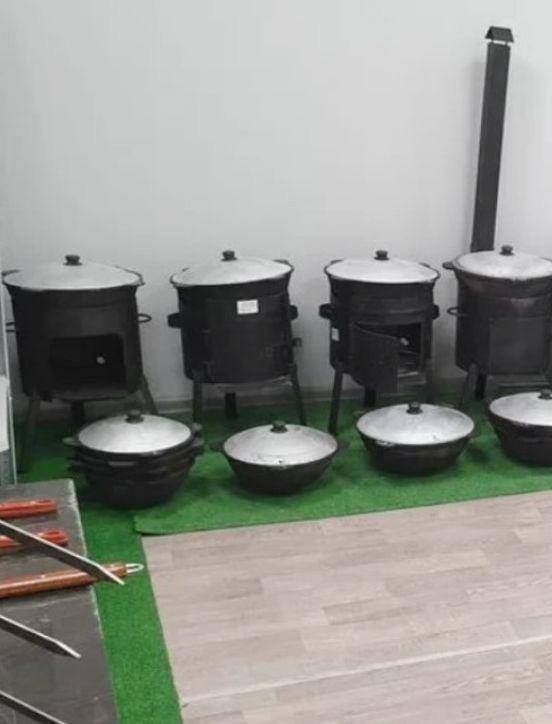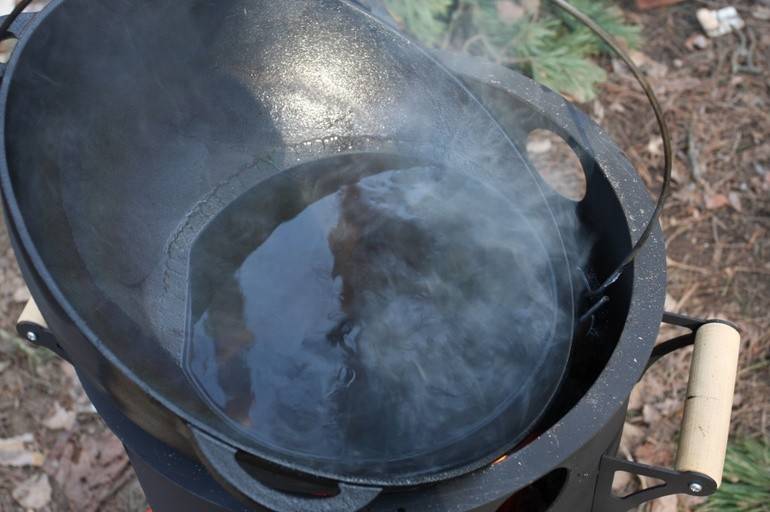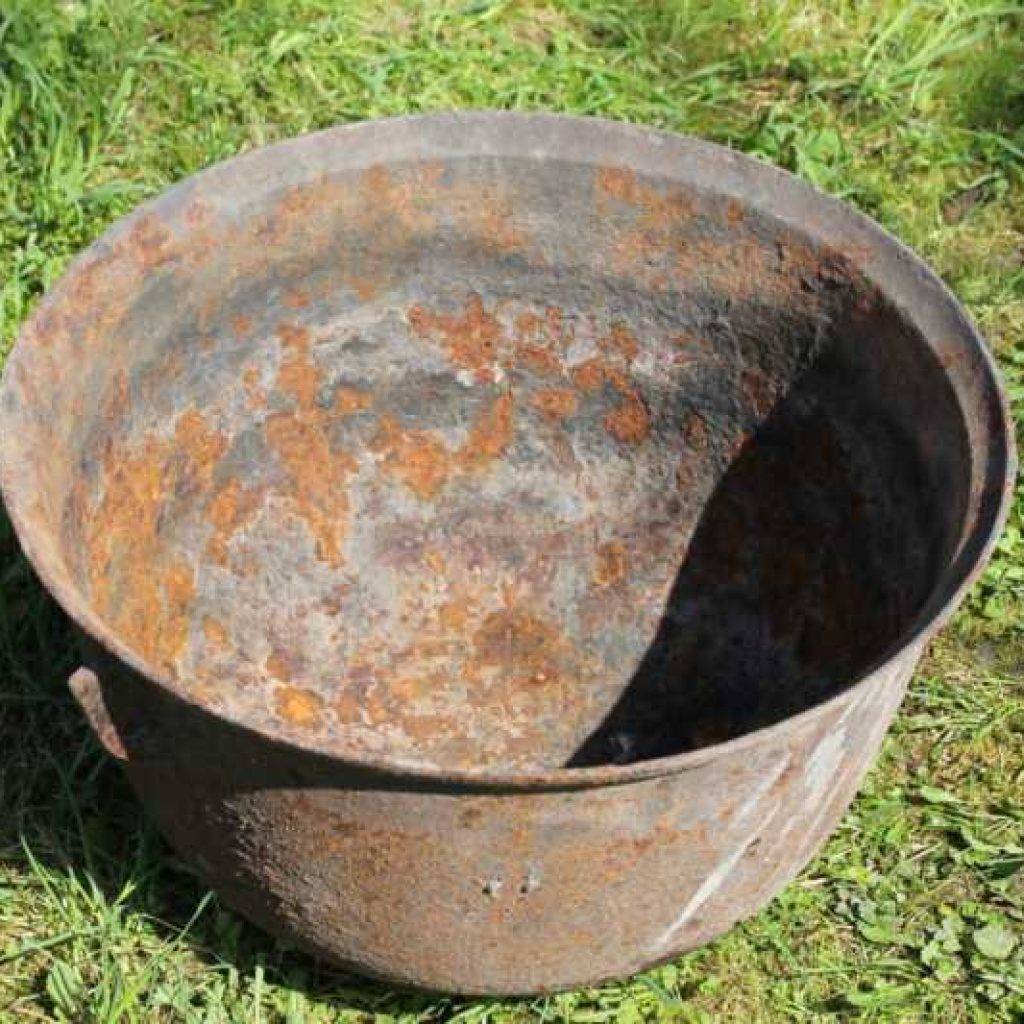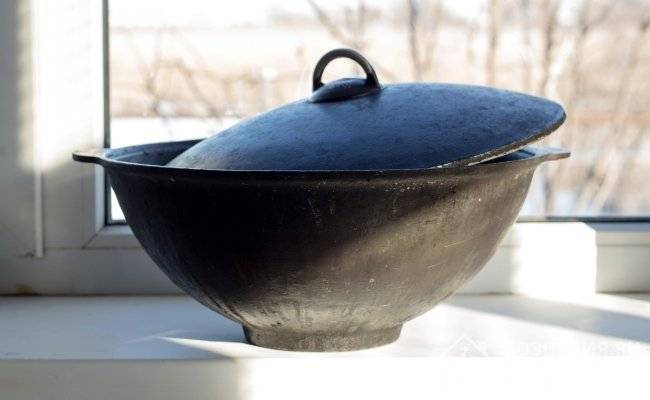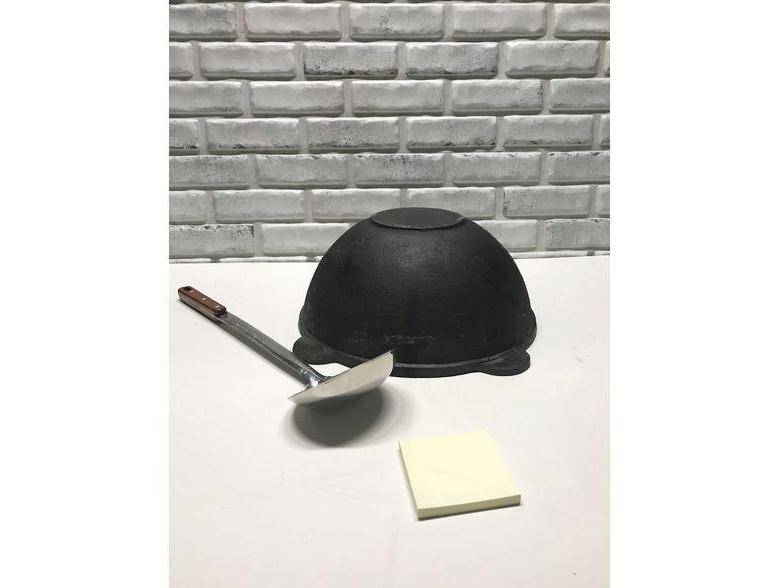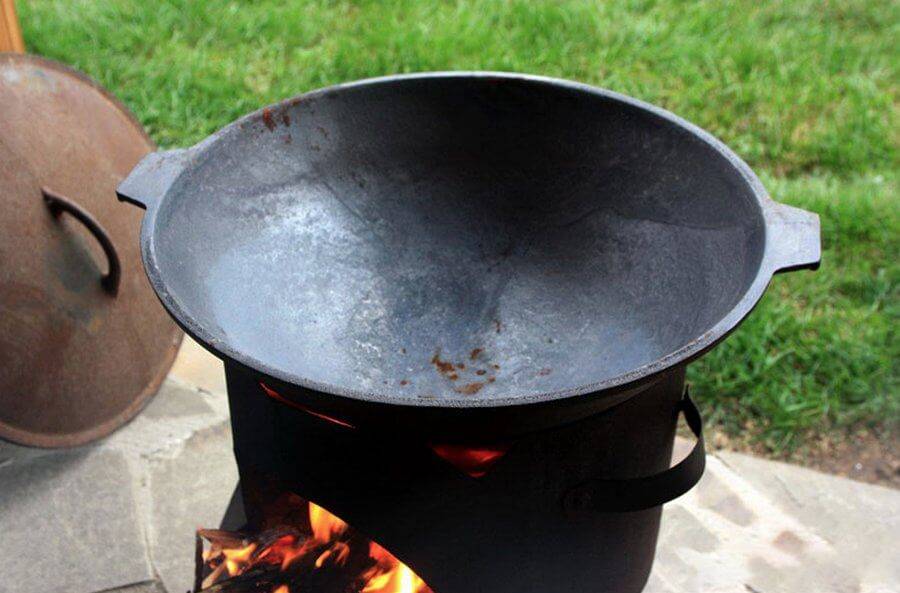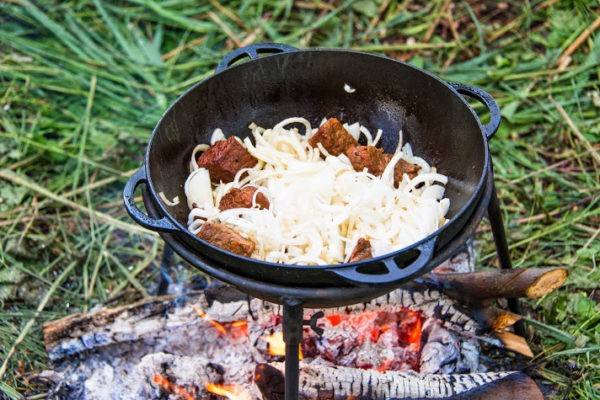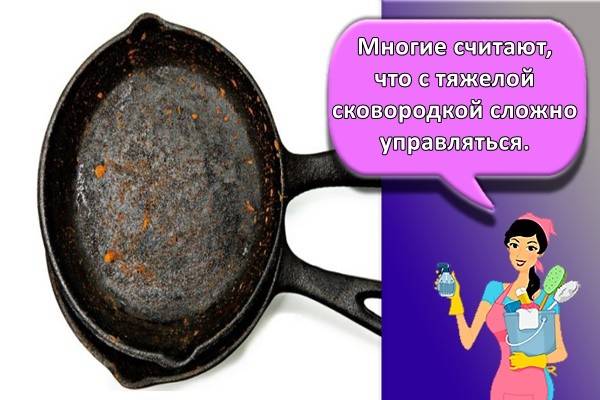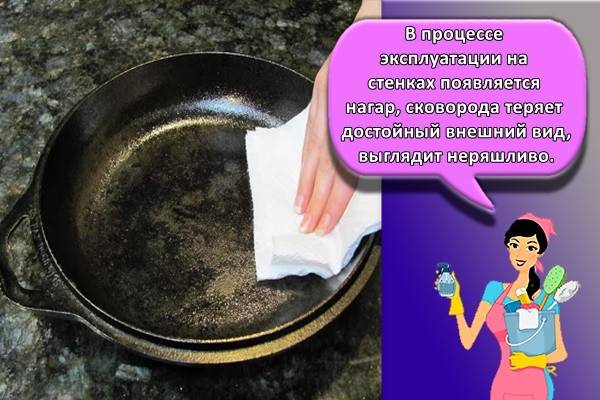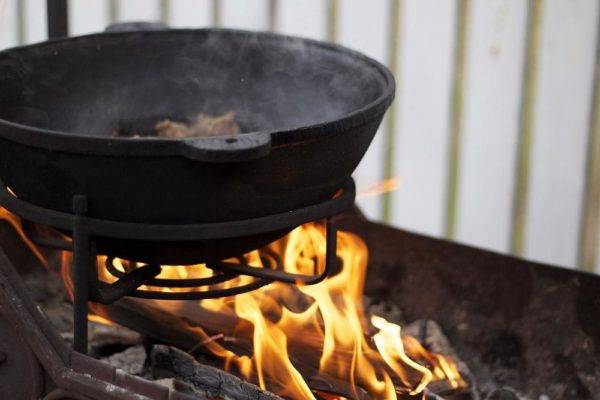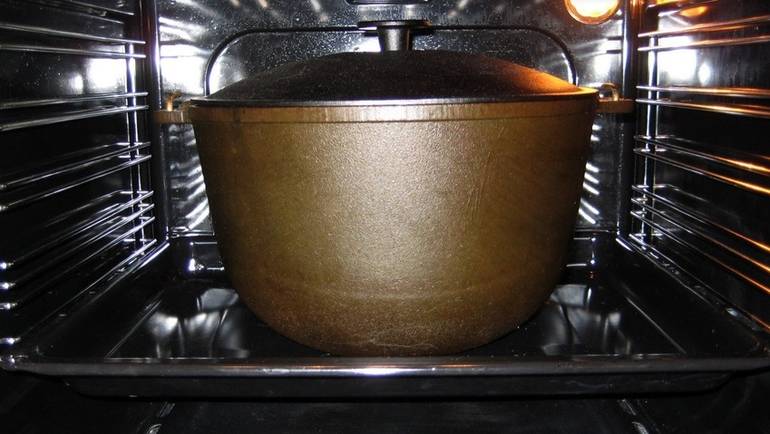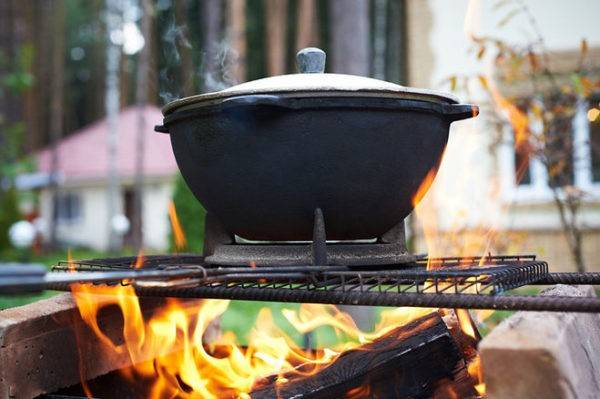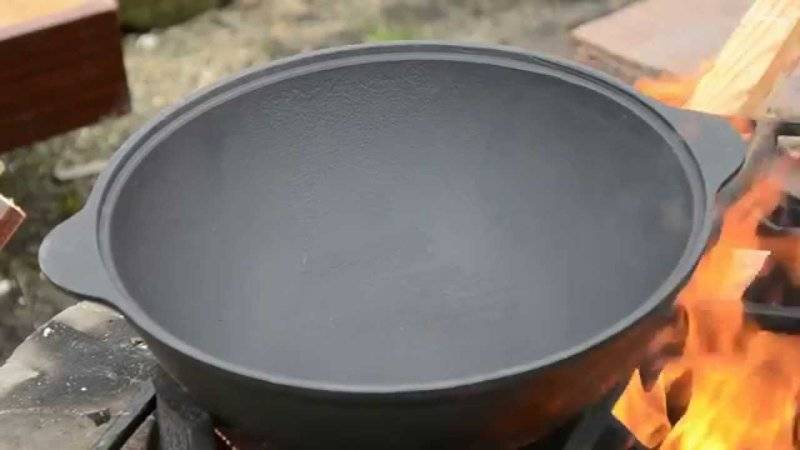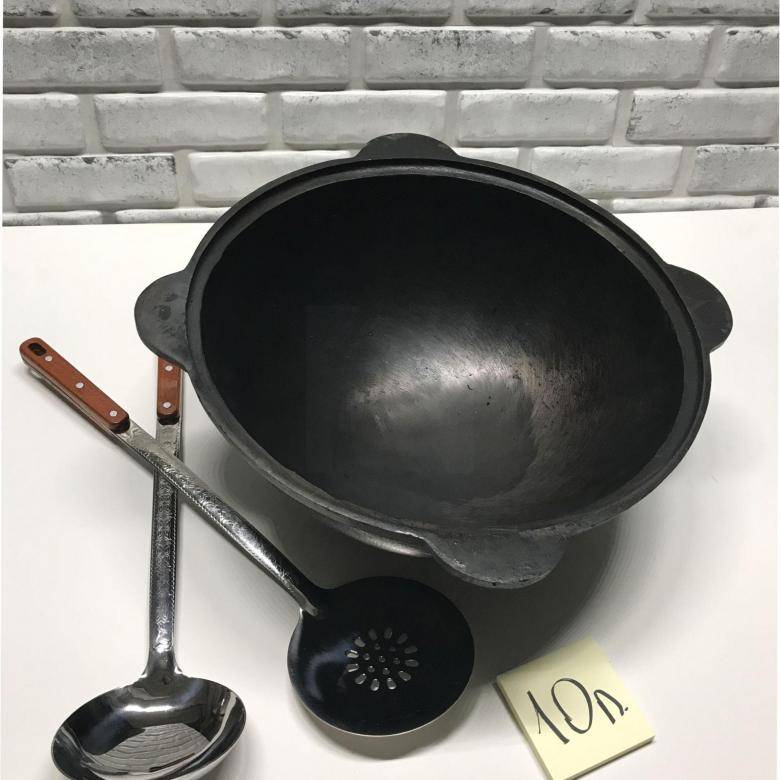Care Tips
After processing a new cauldron, you must adhere to the rules of caring for it. They are as follows:
- After cooking, it is better to transfer hot food to another dish.
- Be sure to thoroughly clean the cast iron from food residues and rinse without detergents.
- Wipe dry and put in place.
The dishes should not be damp during storage, it is advisable to wipe them with a dry cloth from time to time. When using harsh detergents, the non-stick properties may be lost, so the product can be oiled again. Cast iron dishes are very reliable and if you know how to store the cauldron correctly, then it can serve forever.
It is important to remember that baking is not only beneficial for new cookware. The procedure is recommended to be carried out if burnt food remains on the cauldron
If abrasive products are to be used, the dishes must be burned, then a layer of oil must be built up.
How to clean a cauldron at home?
Despite the unattractive appearance, rust, at least at the initial stage of appearance, will not do much harm. But, of course, you need to clean the cauldron. How to do it at home? Naturally, with the help of improvised means that can be found in almost any home.
Among the popular methods, an ordinary vegetable is in demand, which can be found in every refrigerator. Raw potatoes do a great job on light rusty deposits.
A 1: 1 mixture of vinegar and water will help get rid of a thicker layer - a cauldron is immersed in it for 3-4 hours. After aging, coarse salt is mixed with vegetable oil, and the walls of the dishes are wiped with this mixture.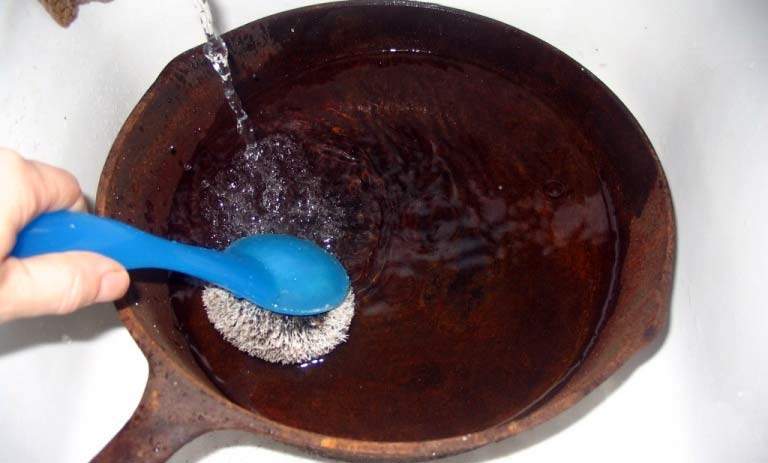
But the most famous way is digestion. He is the most complex, but universal. Digestion will help get rid of not only rust, but also of soot, soot, everything that spoils the walls of the dishes. For digestion, a mixture of laundry soap and office glue is used. Soap needs a whole bar, 100 g is enough glue. All this dissolves in water, a cauldron is placed in the solution (it needs to be immersed in its entirety), and it is cooked for about 4 hours on low heat. After such cooking, all carbon deposits and rust can be easily removed with a regular dishwashing sponge.
Is there a lot of rust, and has it penetrated deeply? Sandpaper and cola will help
Pepsi, Coca - not so important, both drinks contain phosphoric acid, namely, it eats away rust. Immediately the walls are processed with sandpaper, after cleaning, the cauldron is completely immersed in cola, the liquid is brought to a boil and turned off
The dishes are not removed from the cola until they cool down.
After each cleaning method, the cauldron is thoroughly washed with water, wiped off with a dry towel and must be ignited with oil.
Prevention of corrosion and care of a cast iron cauldron
Any dishware needs a careful and responsible attitude. If, after cooking, the cauldron was poorly washed, did not wipe it dry and put it in the closet, then it is not surprising that soon rust will appear in it.

Do not store the cauldron in a damp place. After washing, the utensils must be thoroughly dried and only then put away for storage.
To prevent this from happening, you must follow a number of rules:
Before the very first use, the cauldron is calcined
This makes it more durable, food will not stick to the walls, and it will be easier to wash it.
After washing, the cauldron should be wiped well with a soft cotton towel, and left in the open air for some time to ventilate and dry better.
Important: the boiler should be cleaned immediately after the end of cooking. Then you don't have to mess around with dried food debris and ruin the surface with hard shuffling.
Do not use aggressive agents and iron sponges: they destroy the non-stick layer
A regular kitchen sponge and an odorless liquid soap are enough for effective cleaning.
It is not recommended to pay attention to advertised anti-rust agents. All of them contain harmful substances that only worsen the situation. It is much better to use “grandmother's” means.
Only newly appeared, barely noticeable rusty dots are perfectly removed with the juice of an onion or raw potato.
Daily care rules
Daily care can only be talked about if cast iron cookware is used every day.
If the hostess has a lot of pans that she uses according to her mood and need, it is important to ensure the correct storage of cast iron utensils
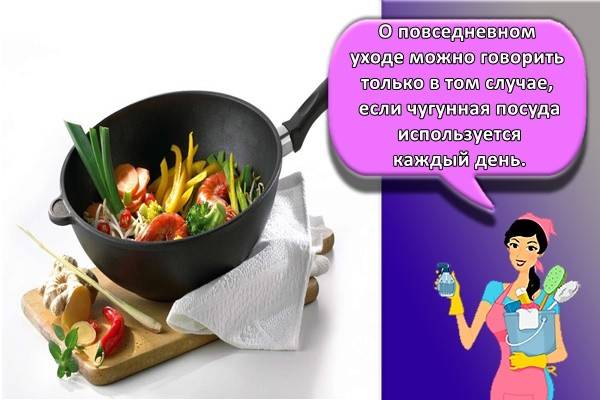
Enamel coated
Frying pans and cauldrons covered with a layer of enamel are great for boiling and stewing for a long time. The enamel layer adheres firmly to the cast iron, so as not to chip or destroy it, the following care rules should be observed:
- do not put hot dishes under cold water;
- do not clean with abrasive powders;
- after removing food, warm water is poured into cold dishes, mild soap is added, left for 20-60 minutes, washed with a sponge, dried;
- if the burnt food does not leave, the cauldron is poured with water, liquid soap and a spoonful of soda are added and boiled for several minutes.
Enamel coating is less demanding to maintain than plain cast iron
It is important not to chop it off, not to tear off the burnt remnants with a knife, wait until they soften in the water themselves. Too aggressive exposure leads to a gradual thinning of the enamel layer, the dishes lose their presentable appearance, but not their properties
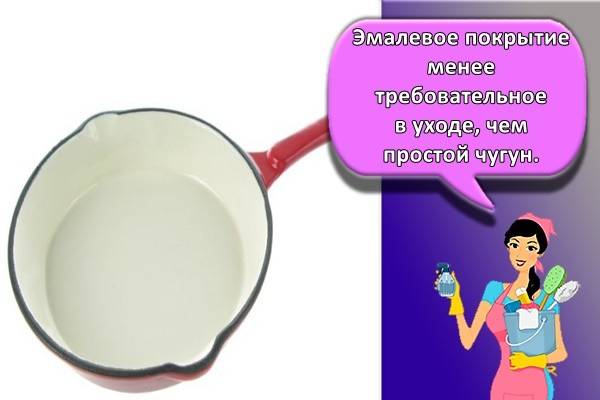
Without cover
The main advantage of a cast-iron frying pan is the formed oil layer on the surface, which prevents food from burning. When leaving, the main task is to preserve this impregnation. Therefore, it is required to handle cast iron cookware as follows:
- remove food from the pan immediately after cooking;
- do not peel off food debris with a knife, abrasives, metal mesh;
- do not use strong grease solvents for dishes;
- do not soak pans with soapy water for a long time;
- do not boil water with soap.
Cast iron is a porous material. The more often you cook in the pan, the better it becomes, the walls become shiny. If the frying pan is used regularly, do not use aggressive chemicals when washing, do not store in a damp room, there is no need to grease it with oil after wiping it off.
4 ways to properly anneal a cast-iron cauldron
The essence of the technique is to heat cast-iron dishes to a temperature when industrial grease begins to burn, forming smoke and soot. The procedure is carried out in stages using home remedies.
Calcining with table salt
Instructions on how to burn a new cauldron made of cast iron or aluminum in an apartment:
Take precautions first by opening the windows in the kitchen. Otherwise, oil fumes will cause household poisoning.
Pour a box of coarse salt into the bottom of a cold cauldron.
Then turn on the stove.
Stir table salt until light brown.
Now turn off the oven, leaving the dishes to cool down.
After discarding the used salt, thoroughly clean the surface with a thick layer of toilet paper.
Important! Take precautions. Hot salt, if it gets on the skin, burns the face and eyes.
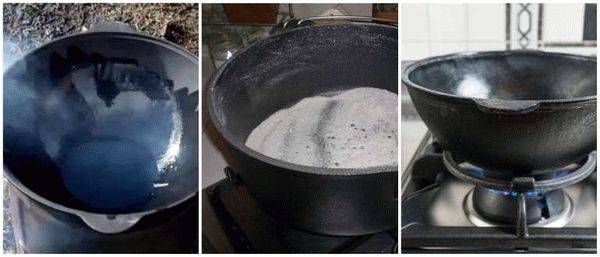
Oil treatment
In order to do everything right at this stage, the cauldron is treated with oil for firing. The technique will allow filling the porous structure of cast iron with a strong film
The procedure is carried out observing the precautions:
The bottom of the dishes is covered with vegetable fat - sesame, linseed, sunflower
Lard, cooking oil will do.
During heating, carefully pour the inner surface of the product with a slotted spoon.Manipulation lasts no more than 20 minutes
Fat, getting on the walls, fills the pores of the cast iron. The walls of the container become smooth and shiny.
Thus, the cauldron at home acquires a non-stick coating. It is this that prevents food from sticking during cooking.
Attention! The heated fat tends to splatter. Do not remove the cauldron from the heat until it cools down
Hot oil creates the risk of a 2nd degree burn.
Processing a cauldron in the oven
There is one more way to process a cauldron. Although it takes longer, it is less smoky. You can ignite cast-iron dishes in the oven: grease the cauldron with vegetable fat, put it in an oven heated to a temperature of 180 ° C. The holding time is 5 hours, but at 250 ° C it is half an hour. The hood must then operate at full capacity. It is advisable to burn with oil several times.

Roasting over an open fire
Acrid smoke is emitted during calcination, so it is best to carry out the procedure outdoors. All actions are carried out in turn, using first salt, then vegetable oil.

Here is a technique for igniting a brand new cast-iron cauldron over a fire:
First, a fire or stove is kindled in the yard.
Now the container is burned over high heat. Where the fat burns out, lighter spots appear. When most of the boiler is ignited, wipe the surface with paper.
Coarse salt is poured
During heating, the crystals are gradually scattered with a slotted spoon along the walls of the container, being careful - hot grains are dangerous.
After cooling, the product is washed with a hard sponge.
Attention! Do not pour water into a hot cauldron - it may burst due to temperature changes.
Repeat calcination while cleaning the walls with paper.
Pour some oil, spreading it with a slotted spoon along the walls of the container.
When the dishes have cooled down, drain off the remaining fat. Wipe the inner surface with paper.
After finishing the procedure, wash the product with warm water. Boiler cleaning agents are not used because they destroy the protective layer.
How to store a cast iron cauldron?
Most importantly, it must be dry. Perfectly dry. Never put a damp cauldron in a cabinet; dry it thoroughly. And, of course, do not store dishes in a high humidity environment. Otherwise, rusty spots will quickly cover the walls of the cauldron. You can fight rust, but why do you need extra trouble if you just need to keep the cauldron dry?
Second recommendation: there should be a layer of oil on the walls of the cauldron. Only on the inside if you use the dishes frequently. Both internal and external, if you put the cauldron for long-term storage.
In the first case, oil is necessary for the successful preparation of dishes - so nothing will stick to the walls. Well, in the second case, oil is the protection of cast iron from dampness, if it suddenly appears.
The third recommendation: do not store the cauldron without access to air, otherwise it will "suffocate". After all, there is a layer of oil on the walls, and if you close the cauldron with a lid or put a saucepan on it ... The aroma will not be pleasant.
Basically, that's all the recommendations. As for cleaning such dishes, there are also few recommendations. It is advisable to wash the cauldron only with water, without detergents, and even more so, without hard washcloths and brushes. Of course, the cauldron must be washed immediately after use, without waiting for the remnants of food to dry on its walls.
If you had to wash the cauldron with a detergent or a stiff brush, you must definitely ignite it with oil. The same procedure should be carried out after cooking something sour in dishes (dishes with tomatoes, stewed cabbage, and so on).
How to clean a cast iron cauldron
A cast iron cauldron can suffer not only from carbon deposits and soot. Rust, mold or scale can sometimes appear on the surface if not properly handled or cared for. To remove them, use only suitable products and follow a specific sequence of actions.
From rust
First of all, determine the degree of damage to the surface.
If there are very few corrosive areas, use chemical products with abrasive particles and a metal sponge. Rub the small rusty lesions with half a potato. After all the manipulations, rinse the cauldron under running water.
If there is a lot of rust, try cleaning the area with a detergent first. Then rub the surface with sandpaper or metal shavings. Use both coarse abrasives to remove the top layer of rust and fine abrasives to clean microscopic pores on the surface. You can also remove the thick corrosive layer with a flat head drill or grinder.
Please note that only a specially trained person can work with such tools.
If you don't have household chemicals or tools at hand, try boiling the cauldron in boiling water with salt. To do this, place the container in a bucket and fill it with water, add salt at the rate of 1 kg per 6 liters of liquid. Place the bucket on the stove and boil the dishes for 7-8 hours.
From limescale
If scale has formed on the surface of the cauldron, try removing it with a special kitchen cleaner. From improvised means citric acid, vinegar and hydrogen peroxide cope well with scale. Take enough cleaning agent to cover the entire volume of the container.
From mold
It is, of course, better to prevent the growth of mold. To do this, it is enough to wipe the container dry after each wash. If an unpleasant fungus nevertheless appears on the surface, the cauldron will have to be ignited on the stove, fire or in the oven.
Calcining a new cast-iron cauldron
Cast iron is a material that is made by pressing or casting an iron alloy. The composition contains a small percentage of carbon, which over time leads to the formation of corrosion. To prevent this from happening, in the production of dishes, they are treated with technical oil. Before the first use, it is required to remove the production grease by calcining. It is performed once after purchasing the dishes.
You can remove the oily coating with salt. If the activity is carried out in an apartment, it is recommended to ventilate the room as sufficient smoke will be generated. Salt is poured into the cauldron, the stove is turned on. Stir the salt periodically, wait until it turns brown. Then it is removed, the walls of the container are wiped with paper. The second stage of processing is started.
A cast-iron cauldron is lubricated with sunflower oil so that the walls inside are saturated, a film forms. It protects food from sticking and sticking. Sunflower oil is poured into the cauldron and the dishes are heated. Animal fat is suitable for lubricating the walls. It is optimal to use linseed oil, it clogs the pores of the metal faster, forming a thin film on the surface. Warm up the container with oil for half an hour. Next, turn off the stove, cool the cauldron, wipe the walls with a clean rag. The utensils are then ready for cooking.
Preparation and use
After the purchase, the cast-iron cauldron, like the frying pan, cannot be used immediately. It is necessary to ignite the dishes to remove the remaining machine oil and create a non-stick layer. First you need to wash the container on each side with warm water, wipe it off and heat it on the stove. When the smoke stops going, pour 0.4-0.7 liters of vegetable oil and reduce the heat.
Turn the cauldron so that the oil falls on the walls and is evenly distributed inside. Follow the procedure when the surface turns slightly reddish, but not completely red. Then we cool the dishes, drain the oil and wash in warm water without soap and other means. When the water drains, wipe it with a dry clean cloth or paper towel. For more information on how to anneal cast iron cookware, see here.
To cook in a cauldron, you need to follow several principles.First you need to melt the fat (lard) or vegetable oil. Then the onion is thrown there and fried until it acquires a bronze hue. She pulls out bad smell from cast iron. After frying, remove the onion and cook as desired.
The first manipulations, namely frying, are performed over high heat. Then they put spices and other ingredients, which are stewed already under the lid and over low heat for quite a long time. This principle is suitable for the preparation of any kind of food. And in order for the dishes to serve for a long time, to retain their original properties and appearance, you need to properly care for the cast-iron cauldron.
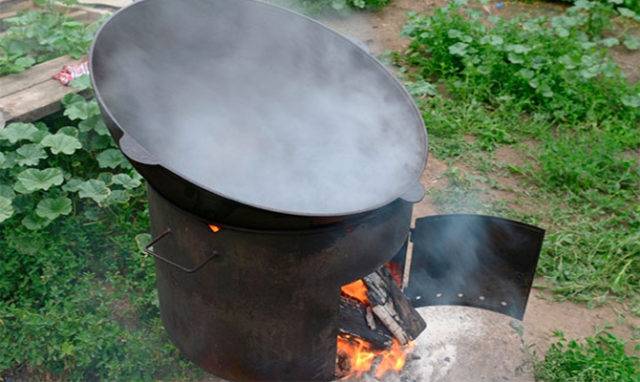
Video
Watch a video on the topic of the article:
In the past, she was a successful lawyer who radically changed her lifestyle. In the new role of wife and mother, the ability to highlight the main thing and "put everything on the shelves" remained unchanged. I am always ready to share my discoveries and accumulated experience.
Found a bug? Select the text with the mouse and click:
If the first signs of bearing in the form of untidy pellets appeared on your favorite things, you can get rid of them using a special machine - a shaver. It quickly and efficiently shaves off clumped fabric fibers and makes things look worthy.
Before removing various stains from clothes, you need to find out how safe the selected solvent is for the fabric itself. It is applied in a small amount to an inconspicuous area of the thing from the wrong side for 5-10 minutes. If the material retains its structure and color, you can move on to stains.
Threads made of gold and silver, which in the old days were used to embroider clothes, are called gimp. To obtain them, the metal wire was pulled for a long time with pliers to the state of the necessary fineness. Hence the expression "pull (breed) gimmick" - "engage in long monotonous work" or "delay the execution of the case."
The easiest way to remove scale and carbon deposits from the soleplate is table salt. Sprinkle a thick layer of salt on the paper, heat the iron to maximum, and press the iron several times over the salt mat using light pressure.
There are special traps to fight moths. The pheromones of females are added to the sticky layer with which they are covered, attracting males. Sticking to the trap, they drop out of the reproduction process, which leads to a decrease in the moth population.
The dishwasher is not only good for dishes and cups. It can be loaded with plastic toys, glass shades of lamps and even dirty vegetables, such as potatoes, but only without the use of detergents.
Fresh lemon is not only suitable for tea: clean the dirt from the surface of the acrylic bathtub by rubbing with half a cut citrus, or quickly wash the microwave by placing a container with water and lemon slices in it for 8-10 minutes at maximum power. The softened dirt will simply be wiped off with a sponge.
The habit of using the washing machine “sparingly” can lead to an unpleasant odor in it. Washing at temperatures below 60 ℃ and short rinses allow fungi and bacteria from dirty clothes to remain on the inner surfaces and actively multiply.
Stretch ceilings made of PVC film are capable of withstanding from 70 to 120 liters of water per 1 m 2 of their area (depending on the size of the ceiling, the degree of its tension and the quality of the film). So you don't have to worry about leaks from the neighbors on top.
How to care for a cast iron cauldron
If you properly take care of the cast-iron cauldron, handle, properly operate and store, then it will serve for more than a dozen years.
If you just bought a cauldron, then it must be processed, this must be done without fail. A new pot is lubricated with machine oil in production in order to protect it from rust; in order to remove a layer of oil, the dishes must be burned over an open fire. It is advisable to do this not indoors, as there will be smoke and an unpleasant odor.
After calcining, the cauldron must be rinsed with warm water.Now we proceed to calcining, take the simplest and cheapest refined oil 1-1.5 liters, pour it into a container and put it on high heat. In order for the cauldron to completely ignite, periodically its sides must be watered with oil. Better yet, tilt the pan on its side and turn it slowly so that the oil flows around the walls.
Be careful not to spill oil on yourself. The procedure can take from 30 minutes to an hour.
When the cauldron cools down, pour out the oil, and thoroughly rinse the dishes with water and use a soft sponge. Thus, we create a protective layer that not only protect the cauldron from rust, but also from food burning.
To ensure maximum protection, coat the cauldron with oil, use a rag and put it on the fire again, wait for the oil to burn out, and do this several times.
If you cook in oil, the protective layer will strengthen, but if you stew vegetables with tomatoes, cook cabbage rolls, or meat in wine, then the protective layer will collapse. In order to properly care for the cast-iron cauldron, the calcination procedure will have to be repeated periodically.
You can not leave the cauldron with food leftovers, you need to wash it immediately and without the use of chemicals, as they destroy the protective film. If the food is burnt, then pour water into the bowl and put it on the fire for 10-15 minutes. After washing, the cauldron must be wiped dry and greased with sunflower oil.
It is imperative to store cast iron dishes in a dry place, as moisture can form rust. If it appears, then the rusty deposit must be removed and the calcination procedure repeated.
How to anneal a cast-iron cauldron at home
If you bought a new cast-iron cauldron, do not rush to put it on the stove, filling it with the ingredients in accordance with the recipe. First, it must be ignited over a fire.
Otherwise, when cooking in it, everything will burn, stick, and even be saturated with the smell of machine oil, which is used to process products, sending them from the factory to warehouses so that they do not rust. You can only guess how many curses you will utter when you scrape off the remnants of spoiled food.
Of course, you won't ruin the cauldron itself. Cast iron cookware is such a thing that is afraid only of falling from a great height, because the metal is fragile. Yes, humidity, because it rusts mercilessly.
Therefore, it is better to spend a certain amount of time and effort to prepare the purchase for a long and practically eternal service. We will secrete the delicacies of food cooked in cast-iron dishes in natural non-stick film and its thick walls.
Non-stick qualities are obtained from fats and oils, which are used in cooking. When heated, it eats so firmly into the pores of the metal that a strong, smooth coating is obtained that prevents burning.
All products simmer evenly and slowly. This quality is ensured by thick walls. The heated metal transfers heat slowly and evenly to the food. Both pilaf and porridge are especially tasty. Such food is useful even for those who toil with the stomach and are forced to give up fried and fatty foods.
So, in order for the cauldron to serve forever and the pilaf always turns out to be amber and fragrant, you will have to work hard to ignite it. Without this procedure, a natural non-stick film will not form and food will stick to the walls of the dish.
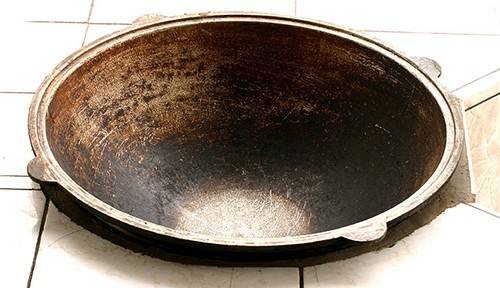
Calcining a cast-iron cauldron is carried out in two stages. But only once - before the first use, if you bought a new vessel.
How to wash a cauldron after cooking
Porous alloy dishes do not like aggressive cleaning. The pores are clogged with detergent, the surface will have to be rinsed for a long time with running water. The oily non-stick layer is destroyed.
How to wash a cauldron? After cooking, the food is laid out in another dish, it cannot be stored in porous metal, the dishes will acquire an unpleasant smell. After pilaf, other dishes that are well steamed, it is enough to remove food debris from the vessel.After that, it is enough to wash the utensils with warm water without detergents, wipe well. If in this way it was not possible to achieve the expected result, water is poured into the massive utensils to 1/3 of the depth, brought to a boil, covered with a lid. All fat particles are then perfectly removed with a foam sponge.
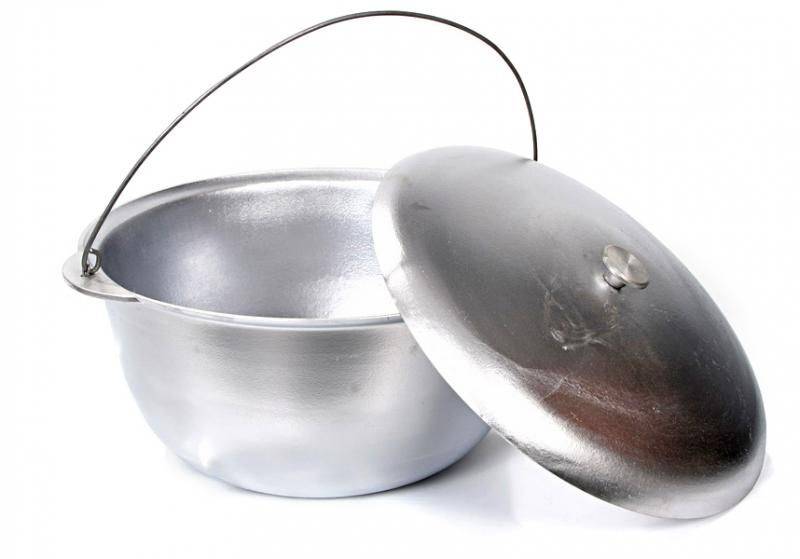 To wash the aluminum cauldron, you can use ordinary dishwashing detergents that do not contain aggressive acids and alkalis.
To wash the aluminum cauldron, you can use ordinary dishwashing detergents that do not contain aggressive acids and alkalis.
Aluminum utensils are easier to clean. To wash it, you can use ordinary dishwashing detergents that do not contain aggressive acids and alkalis. Previously, the places of burning from the inside are smeared with a gruel of salt or mustard powder. Outside, a cauldron used over an open fire is cleaned of soot using traditional methods:
- River sand with grass;
- Coarse salt;
- Ash.
At home, the cauldron is pre-soaked in soapy water, immersed completely in a large container. After that, it is well cleaned under hot water, rinsed, and wiped dry.
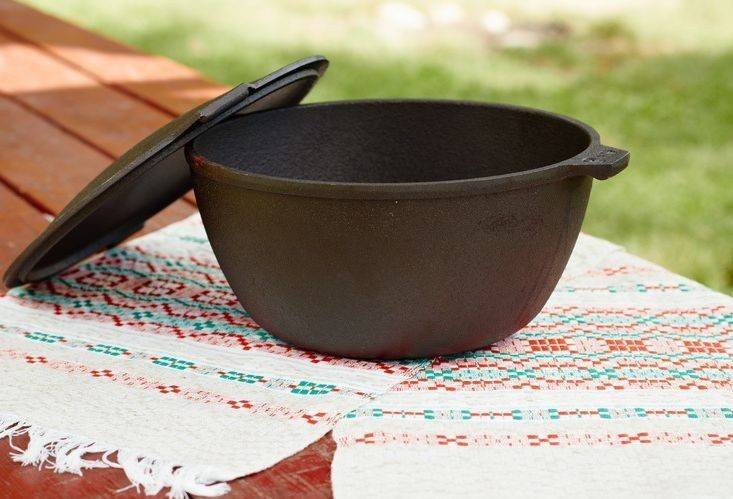 It is best to wash a cast iron cauldron with hot water without soap.
It is best to wash a cast iron cauldron with hot water without soap.
How to wash a cast iron cauldron? Hot water is best without soap. If it is not possible to remove all contamination with water, the correct way to clean cast iron involves gentle washing while maintaining an oily protective layer:
- Mild detergents;
- Dry mustard;
- Soda.
It is necessary to restore the anti-corrosion layer after washing - just wipe the cauldron from the inside with an oiled napkin or cloth.
 With proper care, the cauldron will last for years.
With proper care, the cauldron will last for years.
It is important to protect the vessel from excess moisture: rusty spots form on the cast iron; harmful fungi multiply on the aluminum surface. For long-term storage, it is better to wrap the dish in cotton or linen cloth
With proper care, the cauldron will last for years. What kind of dishes to choose - everyone decides for himself. Aluminum utensils are lighter than cast iron. You can take it with you to nature. Cast iron retains heat longer, food languishes in it, becomes tasty. You have learned how to clean the cauldron quickly and correctly. Take care of the dishes, following our advice, please your loved ones with delicious pilaf and other dishes!
Daily care of the cauldron
How to care for a cast iron cauldron? The non-stick properties of cast iron have been known for a long time.
If your pot has burnt food:
- Pour some water into it, put 2 tablespoons each of salt and soda and put on fire.
- Boil this solution for 20-30 minutes over medium heat, and then make up and let the dishes cool.
- Then you can easily wash the dishes with a soft sponge.
How to get rid of carbon deposits?
What to do if carbon deposits appear on the bottom and sides of the dishes. To cope with this problem, you will need a large basin in which you can boil a cauldron, as well as prepare the following mixture:
- water;
- a bottle of silicate glue;
- grated laundry soap.
Dissolve both components in hot water and put your cauldron in the solution. Put on low heat and boil for an hour. Then scrub it with a sponge and dry it.
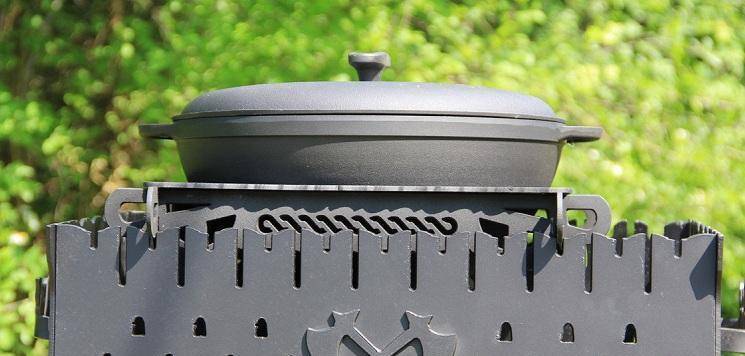
Cleaning the cauldron from carbon deposits with household chemicals
You can use a lye-based oven cleaner to clean your cast iron cauldron. The label should indicate that the composition contains sodium hydroxide.
Application:
- Apply the paste, rub it a little with a sponge into the surface and let it sit for 10 minutes.
- After the specified time has elapsed, wipe off all carbon deposits from the dishes, rinse thoroughly with soapy water, and then rinse with clean water.
- In order to neutralize all the chemistry, rinse the surface of the cauldron with vinegar.
- Wipe dry and carry out the baking procedure with oil.
How to get rid of odors?
Cast iron has one drawback - it absorbs various odors well. If you have cooked any dish with a specific smell, then it may remain during subsequent cooking.
You can easily get rid of the smell as follows:
- Put the cauldron on high heat.
- Pour about a kilogram of salt into it and heat it for 30-40 minutes.
- Stir the salt regularly and distribute it over the sides of the crockery. The salt absorbs odors and removes soot.
- Allow the iron to cool, pour salt out of it and wipe the inner surface with a napkin.
- Then grease the dishes with vegetable oil and reheat.


